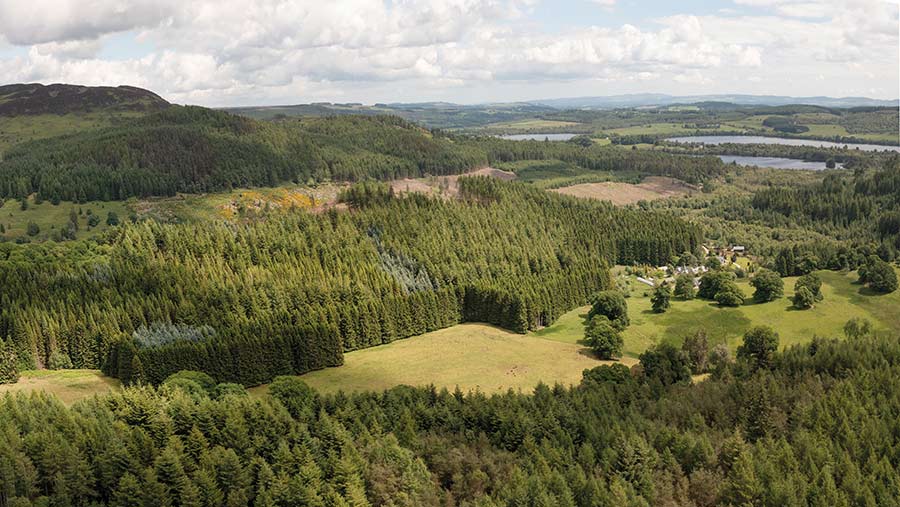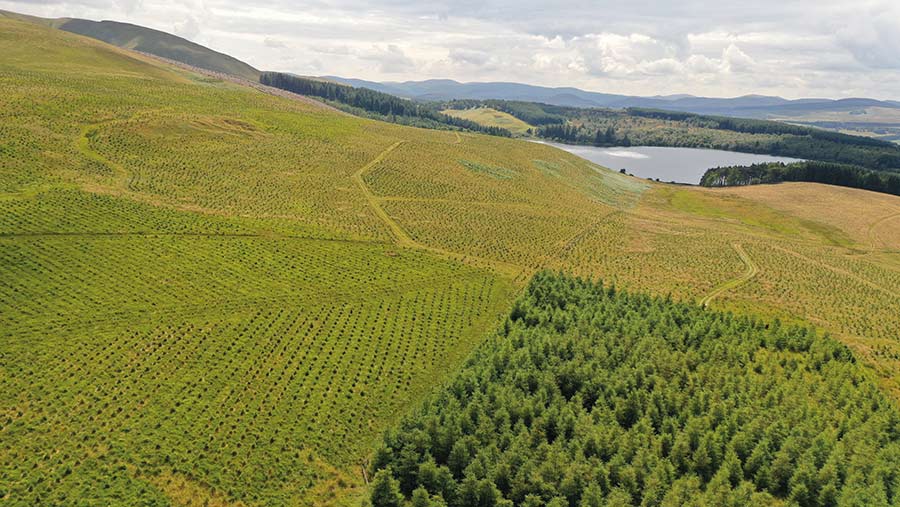Forestry values near £25,000/ha in record-breaking year
Forestry values have shot up in a record-breaking year amid an intensely competitive market with unprecedented demand.
In Savills’ autumn Commercial Forestry report, head of forestry investment James Adamson said that the asset has long been a strong performer, but 2021 saw commercial forest values rise at an extraordinary rate.
Traditionally seen as a secure investment option, this combined with increased political urgency around climate change and biodiversity loss has resulted in unparalleled interest.
See also: The rise of the environmental land buyer explained
Huge competition
Savills’ database covers all open-market forestry transactions and, where possible, private sales conducted prior to the end of the forestry year on 30 September.
The research shows 2021 has broken all records, with average net productive values rising to just under £25,000/ha.
Intense competition in the market and a willingness from investors to step away from conventional pricing metrics have resulted in the sale price of several best-in-class commercial forest properties exceeding the asking price by more than 100% – with most achieving considerably more than expected, said the report.
Although every forestry transaction is unique and averages do hide regional variations, over the past decade average forestry values have increased by about 370%, says Mr Adamson.
During this period, growth has been steady, but the average price paid for a hectare of productive forestry has doubled since October 2019.
The strength of the market is further demonstrated by 40% of transactions during the 2021 forest year achieving more than £30,000/ha, compared with 5% the previous year.
In fact, a number of forest properties sold at record prices of between £40,000 and £55,000 per net productive hectare in 2021.
Prices unsustainable?
For the small sample of forests sold within England and Wales, net productive values look to have doubled during this year.
Meanwhile, south and central Scotland average values increased by 93% and 70%, respectively.
Prices are usually lower in north Scotland and did not have the same dramatic hike as other areas, due to strong value growth already having occurred in recent years and generally lower productivity forests.
Factors such as location, access, tree species, average age, and timber volume and quantity all have a strong influence on the price paid, but competition driven by the imbalance in supply and demand is undoubtedly the key factor.
Forestry is performing well as an asset class, but going forward values of £50,000/ha for early- or mid-rotation timber should not be seen as normal or sustainable – they should be at about one-third of this, based on current commodity prices, says Savills.
What’s on the market?
Scottish offering

Drumbuie Wood © Savills
Savills has launched two lots that are part of the Atholl Estates’ forestry portfolio in the Tay and Tummel Valleys in central Perthshire.
Drumbuie Wood, Dunkeld, includes mixed conifer species with an average age of 36 years across 213ha, with a guide price of £3.5m.
Killiechangie Forest, Ballinuig, has 287ha of mixed rotation and tree type, with an average age of 39 years, guided at £5.25m.
The commercial forestry has a good reputation for high-quality timber.
Autumn launches

Westloch Forest Estate © Goldcrest Land and Forestry
More than 2,500ha of forestry and land suitable for planting is on the market with Goldcrest Land and Forestry.
Eight properties ranging from 90 to 1,025ha, guided at a total of more than £34m, are on offer.
The largest is Westloch Forest Estate, near Peebles in the Scottish Borders, which has a young commercial conifer forest and is available for offers in excess of £11m.
Others include: Angus hill ground (124ha) with planting and carbon sequestration potential, guided at £1.4m; a 495ha upland farm, suitable for planting, in Dumfries and Galloway (£6.75m); and a 425ha holding in Fife with commercial planting land, marginal ground, peat, and solar energy potential (£3.5m).
Also available is a 90ha productive conifer forest in Cumbria (price to be confirmed), a 250ha conifer plantation in Dumfries and Galloway (£7m), 95ha of young crops, maturing timber and land suitable for afforestation in North Lanarkshire (£1.35m), and a 190ha conifer forest with potential for wind energy income in South Lanarkshire (£3.5m).
